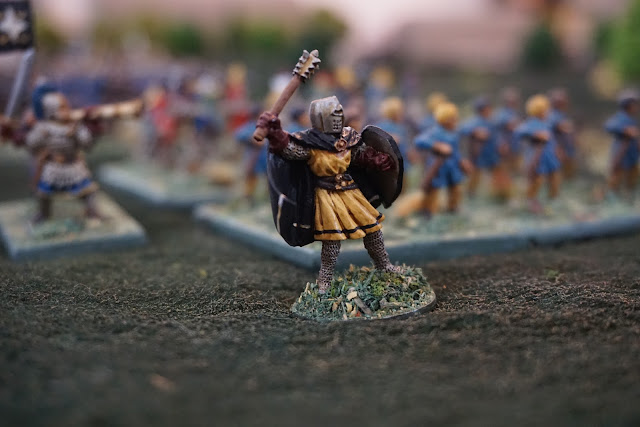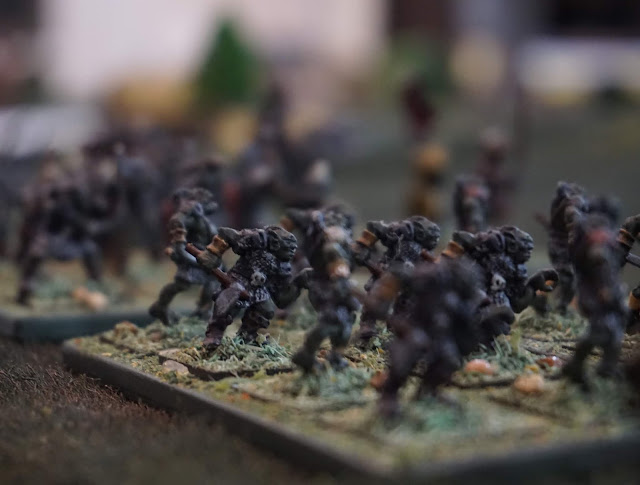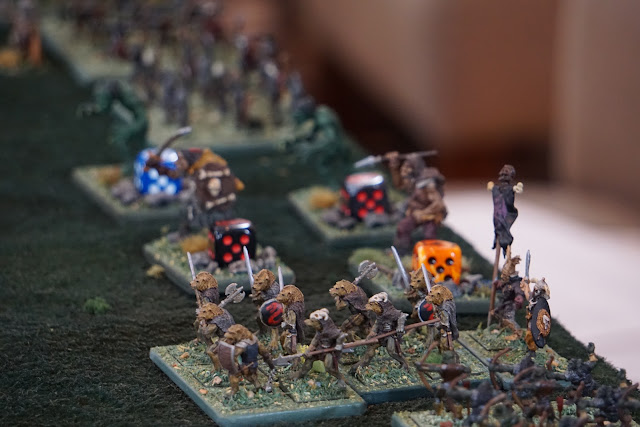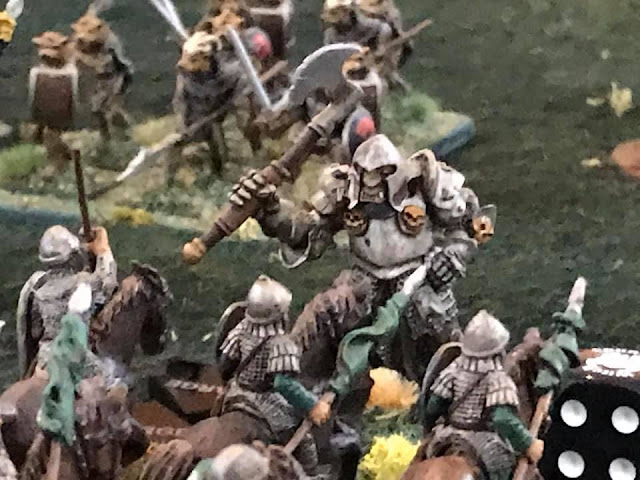In my imagination, Chainmail has always been that shadowy precursor to Dungeons & Dragons that I was both intrigued by yet leery of. I loved the idea of a game involving mass battles in a fantasy setting akin to those depicted in the The Hobbit and The Lord of the Rings, but I also had a sense that Chainmail, released in 1971 a mere year after I was born, was likely a clunky wargame that would be too frustrating to bother mastering. It also didn't help that my first inkling of its existence was around 1980 or so when I could never dream of amassing the miniature armies needed to play out these massive conflicts. No, back then I was pretty sure Chainmail was the province of grizzled old grognards who had started wargaming before I was even born.
Even after my gaming rebirth decades later in 2016, I was fine with letting the dim past remain so, and was more than content during my first couple of years back in the hobby exploring rules of a more recent vintage and manageable scale (i.e., skirmish or slightly larger).
It wasn't too long, though, before I stumbled across a really great set of forgotten wargame rules called Ares that haven't seen a new edition since 1999 and sadly seem to have no real following today. And the thing is, I like those rules better than almost any I've come across yet. They're elegant, fun, and have the perfect balance between crunch and playability for me.
My passions in other areas (illustration art, music, books) taught me long ago that the passage of time hardly guarantees progress or improvement, and that we've lost many things in our ever-accelerating consumerist culture in which planned obsolescence and intentional ephemerality is a feature, not a bug. I began to suspect I was about to relearn this lesson in regards to wargaming.
Following my hunch, I've started to track down other forgotten wargaming rules and unofficial role playing game supplements from the 1970s and 1980s, when role playing games and fantasy wargaming were new. These independently produced old books and manuals offer a fascinating glimpse into the evolution of design thought and the tastes and sensibilities of the time, and I'm finding there really are good ideas hidden away in these discarded volumes.
 |
| A few recent acquisitions... |
His project was made more intriguing when I learned it was going to be a recreation of the Battle of Emridy Meadows, an event Gary Gygax alluded to in the World of Greyhawk set (1983) and was then expanded upon 30 years later in an issue of Dungeon Magazine (#220, 2013). Not only was I finally going to get to try Chainmail, but it was going to be set in some pivotal event in the campaign created by the father of Dungeons & Dragons. I probably should have asked Zach, my fellow Scrum Clubber and mastermind behind the blog Zenopus Archives, for more information, but the hour is late, so I've cribbed the below from a site called The Great Library of Greyhawk:
"The Battle of Emridy Meadows was a critical military event in which the allied forces of good sacked the Temple of Elemental Evil and dispersed hordes of its cultists. Emridy Meadows itself is a series of grassy clearings south of the Velverdyva."
I prepared for the game by perusing my own copy of Chainmail. I had bought a 1977 printing of the original rules a couple of years back, more to satisfy a completist's impulse than with any intention of trying to use them to run a game. I had picked up the 2013 deluxe anniversary re-issue of the original D&D rules, and I was irked that they didn't include a reprint of Chainmail, so I went and found a copy for my set.
Seven of us gathered on January 11 in Scrum Hall to play through the scenario. Keith acted as referee, while us regular Scrum Club members played the opposing sides: Josh O'Conner, Rich McKee, and his friend Andy played the forces of Elemental Evil, while Steve, Francesco, and I played the allied forces of good.
I'm typically so immersed in our games that I find it difficult to prepare much of an after-action report for this blog, especially when there are six of us with a lot of simultaneous movement and combat transpiring at various ends of the table. Instead, below I offer a good number of photos to give you a flavor of the game. Ninety percent or more of the photos are by my lovely and loving wife, Ellen, who memorializes our games so beautifully; any bad photos below are shot by me. Trust me on this. [click any photo to enlarge]
The Battle of Emridy Meadows
 |
| Keith Sloan gives us our pre-battle overview and introduction to the rules of Chainmail! |
 |
| Keith giving Francesco some pointers... |
 |
| (left-ti-right): Josh, Andy, and Steve getting a handle on the rules thanks to Keith's great quick-reference sheets. |
 |
| (left-to-right): Steve, Joe, Francesco, Keith |
 |
| (left-to-right): Steve, Joe, Francesco...the forces of good! |
 |
| Steve, the strategic mastermind for the forces of good! |
 |
| (left-to-right): Rich, Andy (cap), Keith, Steve, Joe, Francesco |
 |
| Me having a good time over some development at the table. |
 |
| Steve quoting Mike Tyson: "Everybody has a plan until they get punched in the face." |
 |
| Is there a better occasion to wear my Sons of Greyhawk shirt? |
 |
| These elven archers were hiding in the forest until we revealed them with a volley of arrows, blindsiding some advancing orcs. |
 |
| See that tree? In about one round the forces of evil are going to discover it's actually an Ent on their flank! |
 |
| Surprise! I'm an Ent! |

 |
| Some elementals that some evil clerics could summon onto the battlefield. |
 |
| My wizard. I got off a nice Fireball and a Cloud Kill spell. |
 |
| These orc archers were hell on one of units of cavalry. |
Parting Shots and Closing Thoughts
Having read through the rule book both just before and then after our Saturday game, my impression is that there has always been a really solid, fun game in Chainmail that was a little difficult to tease out because of poor rule book design and writing. The rules and mechanics themselves are actually very solid...playable and fun. Keith has played in a few games with folks at Gary Con over the years who have been playing since Chainmail was first published and who have filled in any gaps and resolved the small handful of ambiguities in the rule book. Better yet, Keith spent the time to distill the rules and the gleanings from those Chainmail sessions he played into some tremendous play aids and quick-reference sheets that made it all run quite smoothly at the table.
So, who won? Well, we all did, of course!
But in this playtest, the forces of good were headed toward a hard-fought victory that stretched over about 4.5 hours before calling the game.
As mentioned, the point of the game was to help Keith balance the troops and scenario elements to run it at Gary Con this March. Without hesitation I will say that Keith is exactly the kind of GM I want to play a convention game with in terms of preparation and player aids. It also doesn't hurt that his figures and terrain were all lovely to play with, too. I did feel a bit like, at least this first time playing, it was necessary to have a referee to adjudicate a small handful of nettlesome edge cases during play, but I think a lot of that could go away with a bit more rules familiarity and establishing some "norms" by playing repeatedly with the same group.
It was a real pleasure playing a mass combat game for a change, too, as fond as I am of smaller skirmish-level miniatures games. All of the attending Scrummers seem enthusiastic about trying some more battles of this size using Chainmail. Steve, who often has some inspiring ideas after an evening of play, suggested the Scrum Club perhaps come up with our own "Braunstein," complete with a map that roughly corresponds to the Washington, D.C. metro area in which we could all have armies/kingdoms with an evolving history/narrative over the course of semi-regular interrelated games using Chainmail (or other systems, I suppose). Our kingdoms would be roughly located where each of us currently lives in the metro area (our club's members are scattered about the DC-Virginia-Maryland area in a way that would make this a fun paradigm to use to sketch out a fantasy world).
Sounds like one more project for the ever-industrious Second Saturday Scrum Club!
~~~~~~~~~~~~~~~~~~~~~~
And don't forget...
Scrum Con 2020 is almost here!
Silver Spring, Maryland
Saturday February 29, 8:00 a.m. to 8:30 p.m.
There are still plenty of games with seats available.
Register and sign up for some games today!
~~~~~~~~~~~~~~~~~~~~~~~~~~~~~~~~~~~~~~~~~~~













































































































Wow! That game was incredible looking! Love the older figs. I'm also a fan of them. Heritage, Grenadier, Ral Partha and many others. I own Chainmail and played it when it came out. Been a long time. Lately have been playing Chaos Wars by Ral Partha. Have lots of figs and the rules have a following. I've bookmarked this battle so I can keep coming back to look at it. Thanks and enjoy it at the show. please post more pics!
ReplyDeleteThanks so much, John. Glad you enjoyed the post! Hope to see you around more in future comments sections!
DeleteGreat looking game! Love the old school figures ( a few of which I also own!) So massed battles now? Whatever next? Historical wargaming? Only joking!
ReplyDeleteBest Iain
Historicals?!? Let's not go crazy, Iain! (Also only joking.) Always a pleasure to see your name pop up in my comments, my friend across the pond.
DeleteJoe---
ReplyDeleteYou should definitely come to GaryCon sometime, or the North Texas RPG Con (first weekend in June each year): both are excellent havens for old-school gaming! :D
Allan.
Thanks, Allan. Both are on my list, though Gary Con always coincides with a crushingly busy time at my day job, making that less likely. But I'm very tempted to try to attend this year's North Texas RPG Con. I have two or three friends who attend, and as you suggest, it sounds like I would love it from what they've told me.
DeleteThis is the greatest thing I have read all year. I love the pictures and the troops, give me memories of all the Gygax and Dever artworks in the various publications.
ReplyDeleteThis is great, Joe. Where do you get those nice miniatures?
ReplyDeleteBeautiful photos!
(I found Emridy Meadows in Dungeon 221.)
Thanks! Glad you enjoyed it. The miniatures were all part of the referee Keith Sloan's collection. I know he spent a while piecing the armies together. I believe they are all Grenadier and Ral Partha minis from various new outfits who have acquired the licenses and molds to reproduce these. I'll see if I can get Keith to swing by this post with some better answers.
Delete